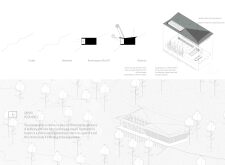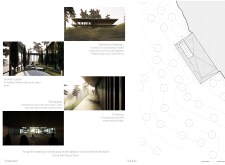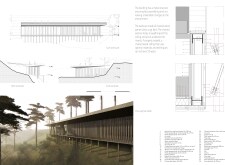5 key facts about this project
This yoga house functions as a dedicated space for yoga classes, meditation, and community gatherings, promoting a holistic lifestyle. The architectural framework is organized to facilitate various activities while fostering an atmosphere of peace and introspection. Central to the project is a spacious practice area, designed with an open layout that not only accommodates different styles of yoga but also allows for the flow of natural light, creating a warm and inviting environment. This connection to nature is reinforced through the large glazed curtain walls that offer panoramic views of the surrounding landscape, drawing the outdoors into the interior experience.
The meditation garden serves as a pivotal feature of the Drishti Yoga House, providing a serene retreat for users to reflect and unwind. This outdoor space has been meticulously designed to complement the architectural dynamics of the building, featuring pathways and platforms that mimic the natural topography. The garden enhances the overall experience by allowing practitioners to immerse themselves in nature, reinforcing the connection between yoga, mindfulness, and the environment.
In terms of materiality, the project employs several key elements that reflect a commitment to sustainability and local craftsmanship. Charred wood panels, used for the exterior cladding through the traditional Shou Sugi Ban technique, not only offer aesthetic appeal but also ensure durability and weather resistance. This choice aligns with the project’s ethos of harmony with nature, avoiding sharp contrasts and instead fostering a timeless relationship between the structure and its surroundings. Additionally, the use of a robust metal framework allows for efficient construction while minimizing ecological disruption.
The floor levels, constructed with concrete, provide structural stability while seamlessly blending into the natural environment. This choice of materials is complemented by thoughtful insulation systems that enhance the building’s energy efficiency, demonstrating a responsible approach to resource use. The design incorporates advanced passive cooling and heating strategies, ensuring the indoor climate remains comfortable throughout the year.
Another distinctive feature of the Drishti Yoga House is its approach to orientation and solar access. The roof design is inclined strategically to allow the installation of solar panels, promoting renewable energy generation for the facility. Coupled with a rainwater collection system, the project showcases a comprehensive mindfulness about resource management, encouraging sustainable practices among its users.
Furthermore, the spatial organization enhances user experience, with clearly defined pathways that encourage movement and exploration. The interplay between internal and external spaces promotes community interaction, allowing users to engage in various activities while remaining connected to the natural world. This layout reflects an innovative architectural idea—where different zones are not only functionally connected but are also visually and experientially cohesive.
The Drishti Yoga House ultimately presents a refreshing approach to architectural design by prioritizing wellness, sustainability, and natural integration. It serves as a reminder of the importance of creating spaces that nurture both the body and the spirit, free from the distractions of modern life. For those interested in exploring the intricate details and architectural considerations of this project further, it is encouraged to review the architectural plans, sections, and designs that elucidate the thoughtful ideas underpinning this inviting space.


























